Wadi Rum
Wadi Rum is a spectacularly scenic desert valley (wadi in Arabic) in southern Jordan. It is also known as "Valley of the Moon" and inscribed on the UNESCO World Heritage List.
Understand
This area of Jordan is quite isolated and largely inhospitable to settled life. The only permanent inhabitants are several thousand Bedouin nomads and villagers. There is no real infrastructure, leaving the area quite unspoilt. Apart from the Bedouin goat hair tents, the only structures are a few concrete shops and houses and the fort headquarters of the Desert Patrol Corps.
Wadi Rum is less a sandy desert but more a mountain desert. Very good pictures can also be made from the area north of the Turkish rail track parallel to the road from the Aqaba highway to Wadi Rum. The best time to visit Wadi Rum is when it is a little clouded, so you can experience the beautiful game of light and shadow in the desert.
T E Lawrence (of Arabia) spent a significant amount of time here during the course of the British-inspired Arab Revolt against the Ottoman Empire during the First World War (1914-1918). Fans of the 1962 film Lawrence of Arabia will be familiar with the landscape, which is not so much sand dunes as it is a mass of soaring cliffs and sandstone and granite mountains (jebel in Arabic).
Wadi Rum has also been used for more recent films, such as 2009's Transformers 2: Revenge of the Fallen, where it stood in for part of Egypt. The distinctive reddish-orange sands that lend the area an otherworldly quality has brought the science-fiction films The Last Days on Mars and The Martian here to replicate the Red Planet on Earth. The BBC documentary The Face follows two British climbers who pioneered routes in the canyons.
Also see the official site.
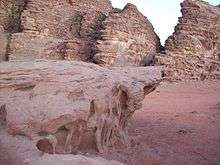
Get in
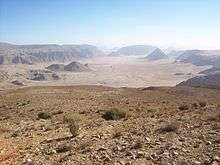
Wadi Rum is a short detour from the Desert Highway between Amman and Aqaba. A side road, 🌍 40 km north of Aqaba, leads 21 km to the entrance where you will find the 🌍 Wadi Rum Visitors Centre, a police office and a lot of potential guides offering camel, 4x4 treks and camps. The cost to enter the Wadi Rum Protected Area is 5 JD per person (free with the Jordan Pass).
Most buses that travel the highway between Aqaba and Petra/Amman should be able to drop you at the intersection to Wadi Rum, except the buses from Jett company. Once at the intersection, you can hitch hike (common in this part of Jordan, no problem for women alone even) or take another minibus (1-2 JD, they seem to turn up quite regularly) to the Visitor's Centre where you can meet your guide or continue hitchhiking to 🌍 Wadi Rum Village (another 7 km). This final leg of the trip shouldn't cost more than 1-3 JD per person.
Avoid the scammers in Petra who try to take you for a tour in the desert north to Wadi Rum for 80 JD. Ask specifically which sites they visit and whether it's in the reserve or not (there are no such things as "Rum 1" and "Rum 2"). However, some tourists are lodged outside of Wadi Rum, e.g. Disah, for more luxurious accommodation. The desert tours however will be the same as the one from the camps within Wadi Rum.
From Aqaba
You can get to Wadi Rum by catching any bus or minibus (1-3 JD) from the Aqaba bus station headed to Amman, Ma'an, or Petra and get off at the Wadi Rum turnoff. The turnoff is well-marked on the highway to Amman, about 40 km out of Aqaba. The buses run north every hour from 07:00-15:00, but another company (Afana) operates them until 22:00, perhaps at a slightly higher cost, however.
The Trust buses depart from its own stations, but basically all the other buses (including minibuses) depart from the main Aqaba bus station.
There is usually at least one direct bus from Aqaba to the Wadi Rum Visitor's Centre and the Wadi Rum Village per day. Be careful though if you plan to go to Wadi Rum on a Friday - it is very possible that these buses are not running (you should ideally go to the Bus Station and ask the drivers the day before). These buses: 1) leave 2-3 times per day during the high season (Spring and Autumn). The last regular bus leaves at 13:00 (or possibly 15:00, according to this and this , but don't count on it). 2) leave once per day during the low season (summer and winter). There is a daily minibus from Wadi Rum Village to Aqaba that leaves at 06:30 (or 07:30 - as of 2011 there is some disagreement), and this returns to Wadi Rum when it is full or the driver feels like it. The minibus journey should cost around 3 JD per person.
A private taxi from Aqaba will cost you 25-35 JD depending on where you are in the city (though 30 JD is the price almost universally quote to tourists, and you may be hard-pressed to get most of them down even to 25 JD), and will take you to the Visitor's Centre. If you decide to make round trip you can arrange with taxi driver to wait for you at Visitor's Centre for 3-4 hours and take back. It will cost 40 JD. Taxi drivers usually suggest to take you there at 13:00 and take back after sunset. Taxis from the Israeli border cost around 35 JD.
From Petra
There is one bus per day from Wadi Musa (Petra) that leaves at 06:00 and costs 7 JD. The trip generally takes 1.5 hr and tickets should be booked through your hotel at Petra, it will then collect you from your hotel directly in the morning. The bus stops at the Visitor's Centre and Rum Village and returns to Wadi Musa for visitors travelling on to Petra (departure at 08:00 or 09:00).
Taxis from Petra cost 30-35 JD.
A tour including a taxi ride from Petra, 4 hours in Wadi Rum, not including the 5 JD/person entrance fee, and a taxi ride to the Israeli border cost 130 JD.
From Amman
No bus goes directly from Amman, but regular buses head towards Aqaba or Ma'an. Again, you can get off at the Wadi Rum Intersection (see above). Expect to pay not more than 12 JD, usually only 7 JD. Service taxis will also stop here for you and are generally quicker than the buses. This is not a private taxi, so it will pick up other passengers and make detours as the other passengers require. Service taxis should cost 15-25 JD per person.
A relatively easy, but more expensive way is to take the JETT bus from Amman (4 hr, departs hourly, 8.60 JD, Oct 2018) to Aqaba, then a taxi (1 hr, 25-30 JD) to the Visitors' Centre.
Get around
4x4
Private vehicles are not prohibited past of the village of Wadi Rum. However, if you want to experience the grandeur that the Wadi has to offer, you will need to hire a guided camel or 4-wheel-drive tour. The costs may vary based on the guide, the length of the trip, and your willingness and ability to bargain. You'd get the best price by contacting the local Bedouin directly. The usual price is 50-75 JD per jeep for a 3-5 hr tour or 20 JD per camel/hour.
The 4x4 tours are basically driving around and stopping at several sights, taking short hikes, and having tea. Some tours are only going forth and back, taking 3 hr, for which 50 JD is quite steep. So make sure, when booking your tour, to ensure a 4-5 hr round trip tour.
Hiking
The first camps are between 1-2 hr walking distance away from Wadi Rum village. So starting early, you might want to walk and check out 3 or 4 of these camps, and, if the prices do not fit you, walk back to go further to Aqaba or Petra. Walk out on either side of the valley along the wide truck tracks, depending on where you want to go, because the middle part of the valley is quite sandy and hard to walk on. Or book ahead knowing the name and location of your camp, by calling their number or through any of the common hotel websites. If you are good on foot, walking 10 km into Wadi Rum from the village for your tent is not a problem, but make sure to have a good map (not the one from the Visitor's Centre) and even GPS.
If it is not too hot or you have enough water, you can also hike around instead of paying the 40-70 JD (per jeep) for a tour. You can even reach Umm Fruth Rock Bridge this way (20-25 km i.e. 5-6 hr round trip). It is likely to be picked up by one of the numerous trucks driving through the valley, saving you some distance.
Scams
A scam in the area is that some taxi drivers in Aqaba or other places claim that they can arrange your tour to Wadi Rum. Actually they bring you to Shakariya village which is only a few kilometres away from Wadi Rum visitor centre. And the Bedouin there can also offer the 4x4 that drive you around the area just north of Wadi Rum Natural Reserve. The taxi driver profits from the ticket fee that they claim to pay to Wadi Rum and price difference between 4x4 in Wadi Rum. The scenery there is also very good, and the area also has something resembling the "Seven Pillars of Wisdom" and the rock bridge in Wadi Rum. But this is not Wadi Rum after all. Some tourists are not even aware that they actually have never been to Wadi Rum after the tour.
In Petra, some try to take you for a tour in the desert north to Wadi Rum for 80 JD. Ask specifically which sites they visit and whether it's in the reserve or not (there are no such things as "Rum 1" and "Rum 2").
See
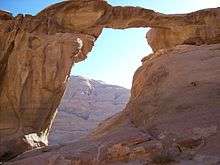
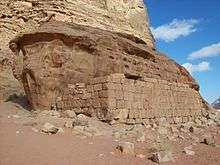
- Lawrence's house. Nobody is certain that this was Lawrence's house, although there are stories that he both stayed and/or stored weapons here. The current structure is built upon the remains of a Nabataean building, however, and it's another beautiful spot in the desert. The house itself is bunch of rubble, though, and not very impressive.
- 🌍 Lawrence's Spring. 2 km south-west of the village of Rum. The spring is at the top of a short scramble - head for the fig tree! Although the pool itself is largely unprepossessing, being a stagnant puddle, the views across the desert are truly spectacular.
- 🌍 Nabataean Temple. Near the Rest House in Rum Village. The surrounding area is covered in Thamudic and Kufic rock art.
- The Anfashieh Inscriptions: Not far from the red Sand Dune area this mountain has depictions of a camel caravan from the Nabatean and Thaumadic period.
- 🌍 Burdah Rock Bridge.
- 🌍 Umm Fruth Rock Bridge. A lower rock bridge which is featured on many tours and can be easily scrambled onto.
- 🌍 Red Sand Dunes. There are various places in Wadi Rum where the white and red sands meet, but the most commonly visited is a dune sloping up alongside a jebel - a bit tough to climb up, great fun to run down! It can be difficult ascending those - use small steps.
- 🌍 Seven Pillars of Wisdom. Although most people can only count five, this is an impressive rock formation near the Visitor's centre. It is named after T E Lawrence's book - not the other way around!
- 🌍 Jebel Khaz'ali. This narrow canyon contains numerous Nabataean rock carvings of people and animals. Beautiful.
Do
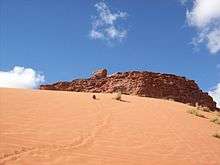
The genuine attraction of Wadi Rum is the desert itself, best seen by 4x4, on camel or foot. Some visitors only spend a few hours in the Wadi, but it's definitely worth staying overnight in Bedouin camps in the desert and taking a guided trip.
The quality 4-wheel-drive tour depends on Bedouin driver who serves as a guide, but often do not have much knowledge and poor English. Therefore picking up a guide at the gate is a hit and miss affair and many of the best guides rely mainly on advance bookings. Many of the guides have websites, through which you can arrange your tour.
Hiking is possible, especially in colder low season. Climbing is another popular activity and a number of guides are also trained climbers. Scrambling the ancient Bedouin Routes to the summits is another great option. Not quite climbing, but more rewarding than a simple hike and can often be combined with climbing or abseiling and/or camping on top of a peak.
The Distant Heat Festival is held every summer on the last Thursday of July which features trance and electronic music.
Hot Air Ballooning is also possible for 100-150 JD. Various companies are available, search the Internet or try this one.
Eat & drink
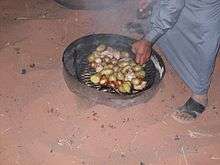
- At the entrance to the park, a small tent-restaurant serves simple Jordanian fare of bread, yogurt and such. There has been one report of food poisoning here, however.
- When you arrive at the Village there are a couple of shops where you can buy water and other soft drinks. Note that almost all the fruit juices are actually labelled as "fruit drinks", with sugar as the main ingredient. You might be able to find some pure fruit juice, such as Tropicana, if you look closely.
- Many camps will provide traditional Bedouin meals. One speciality is chicken or goat cooked under the desert sand, generically known as "zarb" in the same way as we might say "a roast". This has a barbecue flavour, but is very moist and falls off of the bone: try to be nearby when they unearth it as the smell released is gorgeous!
- You won't be able to avoid the Bedouin tea, which is almost forcibly served in every tent you will visit. It's hot, very sweet and usually flavoured with mint and/or sage. It's surprisingly refreshing on a hot day and you may develop a slight addiction to it.
Sleep
The Rest House in Rum village does not offer accommodation anymore and is quite unfriendly about this topic. Also the village is not a place where you want to stay.
Camping
Many official and on the visitor center's map marked camping grounds are available all over the area. Make sure to take all your belongings and rubbish with you when you leave. Also note that it will get very cold at night in the desert, even in summer. This is a great option if you are travelling on a shoestring.
Camps
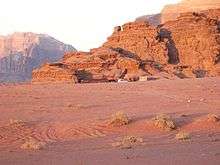
There are several sleeping options, from a more formal camp ground to riding out into the desert with a Bedouin guide and staying in a traditional Bedouin tent. Expect to pay JOD25-60 for accommodation, transportation by 4x4 and food, depending on the type of tour and number of people. Most camps will organise the transport for their guests. Or choose adventure and to stay overnight under the stars or bivouac camping.
Formal camps are the common appearance of accommodation in Wadi Rum. They are all pretty much similar, consisting of about 3-10 tents of 3x3 m with beds, one big common area tent, regular toilet and even semi-warm shower, depending on the hours of sunlight. Power is provided most of the time (not just 5 h). These camps include dinner, breakfast and loads of tea. The standard price for them - assuming they already have at least 4 people there - seem to be 25 JD for a single, but if you are good at bargaining (in the middle of nowhere, or beforehand), you will get it down to 20 JD. This doesn't include transport. The price for two people occupying one tent should consequently be between 35-45 JD. Make sure to get the described conditions, some people ended up in camps with less than that for pretty much the same price.
Apparently, on the usual booking sites such as Booking.com or Google Maps, you can even get a tent from 10 JD—in addition to a proper GPS location. The price however includes only bed and sometimes breakfast, expect to pay another 10 JD for dinner and 10 JD for one way transportation. But, of course, this all depend on you negociation skills.
To find the below listed camps, try a combination of OpenStreetMap, which many mobile Apps like OsmAnd, and MAPS.ME use and which has many camp sites listed, or TripAdvisor (includes the name) and Booking.com (allows booking and contact) to locate the camps, in case you want to organise the transport and hike yourself. Or just head to Booking.com or Google Maps, where you will mostly always also have a GPS location.
Some camps are:
- 🌍 Bedouin Advisor, ☎ +962 776 924 937, e-mail: bedouinadvisorcamp@gmail.com. Traditional Bedouin style campsite inside Wadi Rum protected area, and also offer different kind of activities in the desert such as Jeep tours, trekking & scrambling programs, camels trekking.
- 🌍 Bedouin Directions, ☎ +962 776 886 481, e-mail: wadirum.mehedi@gmail.com. Specializes in longer stays for hiking, scrambling, tailored programs in the wilderness area. The camp is in the south of the protected area in a beautiful and unique location, well located for hiking. Also offers bivouac camping. Jeep tours also available.
- Jordan Tracks Camp, ☎ +962 796 482 801. High-quality camp inside Wadi Rum protected area with all facilities, Bedouin fresh food, private tents, shower, toilets.
- Lawrence Camp, ☎ +962 7 7600 5902, e-mail: wadirumlawrencecamp@gmail.com. Small Bedouin camp with authentic atmosphere, fresh food and bathroom facilities. €25.
- Nawaf Faqeer's Bedouin Desert Camp, ☎ +962 795 537 109. Bedouin desert camp. Campsites are offered both in big or small tents in Wadi Rum. Food is prepared on the fire, and dinner and breakfast are always included in the price. Mattresses and blankets will be provided and transportation is also included.
- Rum Stars Camp, Wadi Rum Protected Area, Wadi Rum Village, ☎ +962 795 127 025, e-mail: rumstarscamp@yahoo.com. Check-in: 09:00, check-out: 12:00. Camping in a real, permanent Bedouin Camp in the shade of a "humbling" cliff face, complete with proper toilets and a shower block. Perfect location for watching the sun rise just outside the camp itself, and a short walk across to the other side of the valley to watch the sun set from atop a mighty dune. They also offer jeep tours into the Wadi Rum Protected Area, Trekking and scrambling with local Bedouin guides, and Camel Trekking with real experienced Bedouin guides - ideal for a ride back to the village from the camp (2-3 hours by camel). US$35.
- Saleh Musa.
- 🌍 Salman Zwaidh Camp, ☎ +962 777 321 069, e-mail: salmanzw.camp@gmail.com. A small Bedouin camp located in the Protected Area of Wadi Rum with about 10 tents for 2-4 people. The camp is run by English speaking Bedouins who will offer you tea at all times a day, and cook food by the fire under the stars. Independently from accommodation, they can arrange on request hikes, jeep tours and camel rides in the desert too.
- 🌍 Seven Pillars Camp and Tours, ☎ +962 777 633 905. One of the most fantastic camping sites with a sunset and sunrise points, a real Bedouin camp with all facilities, a wonderful canyon beside the camp.
- Suleman Abu Musalam and family, ☎ +962 795 902 127.
- The Sunset Camp. Their amenities include tents, running water, showers and restroom facilities. Breakfast and dinner are usually provided - check the camps' own websites for further details. While staying at the camps it is possible to take jeep, camel, or horse tours around the desert and you are often welcome to sleep under the stars.
- 🌍 Abu Yousef Bedouin Camp and Travel Jordan Agency (Abu Yosef Bedouin Camp), Protected area of Wadi rum (the camp is at the edge of the protected area - Near Disi Village), ☎ +962 785311117, e-mail: info@traveljordanagency.com. Abu Yousef Bedouin Camp accessible only by 4x4, its a small camp with basic amenities located on the edge of the protected area, managed by a Bedouin Family, Offering 4x4 ride, Camel ride, BBQ in the desert and all kind of related activities. 35 JD.
- Wadi Rum Desert Tours, ☎ +962 772 538 073, e-mail: wadirumdeserttours@gmail.com. This tour company provides tours of the desert by jeep, camel, or on foot and allows you to camp out under the stars. Aeith, the owner and guide, speaks great English and is very friendly and knowledgeable. Meals and sleeping equipment are provided.
- Wadi Rum Nomads, ☎ +962 795 467 190, e-mail: info@wadirumnomads.com. Specialized tour company offering high quality, authentic jeep tours, hiking and scrambling tours, camel rides and trekking for small groups. For the overnight stay they offer bivouac camping and overnight stays in their Bedouin camp called Wadi Rum Base Camp.
- Wadi Rum Nature Tours & Camp, Wadi Rum Protected Area, ☎ +962 77 9318561, e-mail: wadirumnaturetours@gmail.com. Small camp in a great area. Warm showers and good meals. Owner and guides are very friendly and speak good English. Responds quickly to emails.
- 🌍 Wild Wadi Rum, ☎ +962 772147564, e-mail: wildwadirum@gmail.com. Small family-run business that offer various desert tours, camp accommodation and authentic Bedouin experience.
Stay safe
As with many places, be cautious with anyone who seems interested in romantic entanglements, as incidents of foreign women being charmed by locals and then discovering that the "romance" was merely a cover to obtain sex, money, or other services are not uncommon and increasing. This seems especially true for young foreign travellers. The cosy camp surroundings and maybe some wine does the rest.
Go next
Just as for getting in, the route out of Wadi Rum involves joining the Desert Highway that runs between Amman and Aqaba. Petra is two hours north, and Aqaba is half an hour south, and these are the most common destinations to travel on to after leaving Wadi Rum.
There are public minibuses that run every day at least to Petra and Amman, but these are pretty expensive (20 JD to Amman). Minibuses run mostly in the morning, ask at your camp to have a place booked. There are also numerous taxis waiting for tourists at the parking lot in the Wadi Rum village. Hitchhiking is the cheapest and often the fastest option to get somewhere else. A good way to hitchhike is to ask other tourists at your camp or at the parking lot to give you a ride in their rented car - you will probably find someone who is going to Petra or Aqaba.
To Aqaba
There is a daily minibus from Wadi Rum Village to Aqaba that leaves at 06:30, arriving about 07:30, costing 3 JD.
A private taxi to Aqaba will cost you 15-25 JD depending on where you are heading in the city. Taxis to the Israeli border will probably cost JOD20-25.
To Petra
There is also a daily minibus from the Wadi Rum Visitors Centre to Wadi Musa (Petra) that departs at 08:30, takes around 2 hours, and costs 7.5-10 JD (Oct 2018) per person. Confirm the price with the driver in advance - including luggage which shouldn't cost extra - to avoid any nasty surprises.
Taxis to and from Petra cost roughly 30-35 JD.
To Amman
There is a tourist minibus going from/to Amman everyday for 20 JD as of December 2018. Ask personnel at your accommodation to book you a seat.